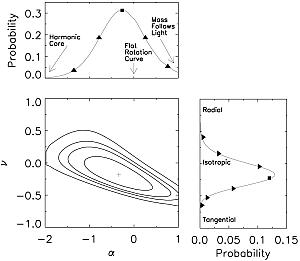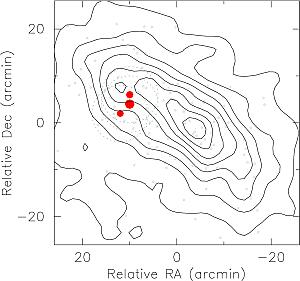First Evidence for an Extended Dark Halo
in the Draco Dwarf Spheroidal
Jan T. Kleyna, Mark I. Wilkinson, Gerard Gilmore, N. Wyn Evans (IoA)
Over the past
several years, we have been engaged in a project to obtain velocities
at large radii in the Draco and Ursa Minor dwarf spheroidal (dSph) galaxies.
Draco and UMi are low-luminosity (
L ≈ 2 ×10
5L
) galaxies about 70 kpc from the Milky Way. Stellar velocity measurements
in the centres of Draco and UMi suggest a central mass-to-light ratio
M/
L
≈10
2 M
/
L
; (
Aaronson,
1983;
Armandroff,
Olszewski, & Pryor, 1995;
Hargreaves
et al., 1996). If this excess mass takes the form of dark matter, then
Draco, UMi, and other dSphs with large
M/
L should be excellent
laboratories in which to study structure formation and dark matter haloes:
low mass galaxies like the dSphs are probably the basic components from
which all larger structures form, and an understanding of the low-mass
end of the galaxy spectrum provides an important constraint for evaluating
Cold Dark Matter (CDM) and other theoretical models of structure formation.
In the past, stellar velocity measurements have been concentrated
in the cores of dSphs, and dynamical modelling has largely been limited
to fitting the central velocity dispersion to an isotropic mass-follows-light
King profile. However, the assumption that mass follows light is known to
be incorrect for virtually all other galaxies, and the assumption of isotropy
masks the crucial degeneracy between anisotropy and mass. Thus, a prime
objective of this work is to obtain stellar velocities at large projected
radii within Draco and other northern dSphs. Combined with modelling methods
that relax the assumption that mass follows light and permit varying halo
shapes, this new data set should allow us to map out the true masses and
shapes of dSph matter distributions.
Draco
With the commissioning of the AUTOFIB2/WYFFOS instrument on the WHT,
it became possible to obtain simultaneous spectra of about a hundred stars
over a one degree field, overcoming the problem of Galactic contamination
near the outer limits of the dSphs’ stellar distribution. In four nights
in June 2000, we were able to measure the velocities of 159 Draco member
stars, extending nearly to the King tidal radius (
Kleyna
et al., 2001). From these data, it is apparent that Draco’s velocity
dispersion remains flat or even increases with radius, strongly suggesting
the presence of an extended dark halo. An isotropic Jeans equation mass
estimate of the mass contained within Draco’s light distribution gives
M
~10
8 M
, with a mean mass-to-light ratio
M/
L ≈ 500
M
/
L
.
By performing a maximum likelihood fit of Draco to a family of dynamical
models parameterised by the halo shape and anisotropy (
Wilkinson
et al., 2002), it was possible to lift the degeneracy between Draco’s
mass and orbital anisotropy. In these models, the overall velocity normalisation
was fitted by the projected central dispersion, the halo shape parameter
a could vary from from mass follows light (α = 1) to constant density (α
= –2), and the logarithmic anisotropy parameter n could be radially anisotropic
(ν > 0) or tangentially anisotropic (ν < 0). The likelihood
contours of
Figure 1 shows the result of our modelling: Draco is fit best
with an isotropic orbital distribution in a halo that becomes approximately
isothermal (α ≈ 0) at large radii. Both a mass-follows-light distribution
and a completely flat halo density are ruled out at the ~2.5σ level. The
best fit mass,
M ~ 8×10
7M
, is similar to the Jeans estimate.

|
Figure 1. Likelihood contours of the fit
of our Draco data to the two-parameter α,ν models of Wilkinson
et al. (2002). The contours are at enclosed two-dimensional χ2
probabilities of 0.68, 0.90, 0.95, and 0.997. The most likely value is
indicated by a plus sign. The top and right panels of each plot represent
the probability distributions of α and ν, respectively; the median of each
distribution is represented by a square, and the triangles show the 1σ, 2σ
and (for ν) 3σ limits. [ JPEG | TIFF ]
|
Ursa Minor
Ursa Minor (UMi) resembles Draco in size, luminosity, and velocity
dispersion. Unlike Draco, it is elongated and appears to have a second
peak along the major axis. Often, this peak is attributed to tidal disruption,
though a plausible mechanism for this has not been proposed. In May 2002,
we undertook a 4-night AF2/WYFFOS run to obtain large-radius stellar velocities
in UMi, with the aim of fitting for the halo shape and orbital anisotropy
using our α, ν models. However, 2.5 nights were clouded out, and poor
seeing limited the quality of the data of the remaining 1.5 nights.
Though our data was insufficient for detailed modelling, we
were nevertheless able to obtain a number of velocities in the vicinity
of UMi’s second density peak. After combining our data set with previously
published UMi velocities, we noted that the velocity histogram of the clump
appeared narrower than the dispersion of UMi as a whole (
Kleyna
et al., 2003). Accordingly, we modelled UMi’s velocity distribution
as the sum of two Gaussians: a Gaussian subpopulation with adjustable normalisation,
width and mean, and an 8.8 kms
–1 Gaussian representing the
bulk of UMi’s stars. We then scanned the face of UMi to determine where
there was a signature of a kinematical subpopulation. As suggested by the
histograms, only the region near the second clump contained statistically
significant (
p = 99.45%) evidence of a second kinematical population
(
Figure 2).

|
Figure 2. Result of search for kinematic sub-populations
in UMi. Coutours are linearly spaced stellar isopleths; the second peak
of UMi’s stellar population is visible above and to the left of the centre.
Gray stars are UMi red giant branch member stars with measured velocities.
The filled circles represent points where a model with a kinematically cold
sub-population is at least 1000 times more likely than a model composed of
a single 8.8 km s–1 Gaussian. The size of each dot is proportional
to the logarithm of the relative likelihood. [ JPEG | TIFF ]
|
We note that a dynamically coherent population can survive inside
a cored halo, because sinusoidal orbits in the (nearly) harmonic potential
of a core do not diverge over time. However, kinematical substructure would
be quickly smeared out if UMi’s halo had a density cusp, as predicted by
CDM. Detailed dynamical simulations demonstrate that a cold clump could
survive for a Hubble time in a ~ 5×10
7 M
UMi-like dSph if the halo has a core larger than ~500pc. If
the halo has a cusp, however, all evidence of substructure is erased within
several hundred million years.
Summary
Using large-radius velocity data obtained using AF2/WYFFOS, we show
that the Draco dSph possesses an anisotropic velocity distribution and
a dark halo that is isothermal in the limit of large radii. In Ursa Minor,
we show that the second peak in the stellar density has a cold kinematical
signature. This signature strongly suggests that the feature is a persistent
clump sloshing back and forth within a dark matter core, and is inconsistent
with the cusped halos that are predicted by Cold Dark Matter theory.
¤
References:
- Aaronson, M., 1983, ApJ, 266, L11. [ First citation
in text | ADS
]
- Armandroff, T. E., Olszewski, E. W., Pryor, C., 1995, AJ, 110, 2131.
[ First citation in text | ADS
]
- Hargreaves, J. C., Gilmore, G., Irwin, M. J., Carter, D., 1996, MNRAS,
282, 305. [ First citation in text | ADS
]
- Kleyna, J. T., Wilkinson, M. I., Evans, N. W., Gilmore G., 2001, ApJ,
563, L115. [ First citation in text | ADS
]
- Kleyna, J. T., Wilkinson, M. I., Gilmore G., Evans, N. W., 2003, ApJ,
588, L21. [ First citation in text | ADS
]
- Wilkinson M. I., Kleyna, J. T., Evans, N. W., Gilmore G., 2002, MNRAS,
330, 778. [ First citation in text | ADS
]
Email contact: Jan
Kleyna (
kleyna@ast.cam.ac.uk)




